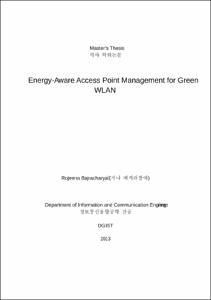Energy-Aware Access Point Management for Green WLAN
- Title
- Energy-Aware Access Point Management for Green WLAN
- Alternative Title
- GREEN WLAN을위한 에너지 인식 액세스 포인트 관리
- Author(s)
- Rojeena Bajracharya
- DGIST Authors
- Rojeena Bajracharya ; Park, Kyung Joon
- Advisor
- Park, Kyung Joon
- Co-Advisor(s)
- Choi, Hang Soo
- Issued Date
- 2014
- Awarded Date
- 2014. 2
- Type
- Thesis
- Subject
- Wireless Local Area Network (WLANS) ; Access Points (APs) ; Energy efficiency ; Received signal strength indication (RSSI) ; 무선 근거리 통신망
- Abstract
-
Over the past few decades, wireless communication has experienced phenomenal growth and has now have become fundamental to daily activities. However, this unprecedented growth comes at a price: due to the always-on usage model, these standards are responsible for a large amount of energy consumption. Optimizing the energy consumption of access points (APs) has become a new challenge for the research community, governments and industries in order to reduce CO2 emissions and operational energy costs.
In this context, wireless local area networks (WLANs) that consist of a high-density of hundreds to thousands of APs are being deployed rapidly in corporate offices and universities to satisfy user demands for high bandwidth, mobility, and reliability. Moreover, these networked APs are provisioned for busy or rush hour loads, which typically exceed their average utilization by a wide margin. In addition, these margins are rarely reached and when reached, last only for a short period of time. Thousands of WLANs worldwide compound this problem, as they remain idle for long periods of time, raising serious concerns about energy losses. In response to this compelling problem, this thesis presents a set of contributions that address the challenge of increasing energy efficiency in Wi-Fi networks. In particular, we introduce novel energy efficient algorithms for dynamically powering off certain APs by exploiting the knowledge of the distance between the User Equipment’s (UEs) and servicing APs while retaining the best user experiences. The network design was mainly evaluated based on the benefits of a centralized structure and the resulting turn off WLAN APs upshot in a network that provides adequate radio signal coverage and the required data rate capacity to serve user traffic demand in the service region. Our proposed algorithms are thoroughly evaluated by means of ns-2 simulations. The proposed solution achieves significant power reduction of the network up to 30 to 40 % compare with always on case without significant reduction of overall network throughput.
In this context, wireless local area networks (WLANs) that consist of a high-density of hundreds to thousands of APs are being deployed rapidly in corporate offices and universities to satisfy user demands for high bandwidth, mobility, and reliability. Moreover, these
networked APs are provisioned for busy or rush hour loads, which typically exceed their average utilization by a wide margin. In addition, these margins are rarely reached and when reached, last only for a short period of time. Thousands of WLANs worldwide compound this problem, as they remain idle for long periods of time, raising serious concerns about energy losses. In response to this compelling problem, this thesis presents a set of contributions that address the challenge of increasing energy efficiency in Wi-Fi networks. In particular, we
introduce novel energy efficient algorithms for dynamically powering off certain APs by exploiting the knowledge of the distance between the User Equipment’s (UEs) and servicing APs while retaining the best user experiences. The network design was mainly evaluated
based on the benefits of a centralized structure and the resulting turn off WLAN APs upshot in a network that provides adequate radio signal coverage and the required data rate capacity to serve user traffic demand in the service region. Our proposed algorithms are thoroughly
evaluated by means of ns-2 simulations. The proposed solution achieves significant power reduction of the network up to 30 to 40 % compare with always on case without significant reduction of overall network throughput. ⓒ 2014 DGIST
- Table Of Contents
-
I. INTRODUCTION 1--
II. RELATED WORK 3--
III. BACKGROUND 6--
3.1 WLAN Overview 6--
3.1.1 Network Capacities and User Density 8--
3.1.2 Coverage 9--
3.1.3 Frequency Channel Assignment 9--
3.1.4 Structure of Service Areas 10--
3.1.5 Redundancy 11--
3.2 Principle of RSSI 11--
3.2.1 Relationships between RSSI and distance 12--
IV. PROBLEM STATEMENT 14--
4.1 High-density WLANs 14--
4.2 Traffic Intensity 14--
4.3 Case Studies 15--
V. PROPOSED ALGORITHM 17--
5.1 Network Architecture 17--
5.2 Power Saving Scheme 18--
5.2.1 Power saving algorithm 18--
5.2.2 Implementation of switch-off scheme 21--
VI. SIMULATION 23--
6.1 Simulation scenario 23--
6.2 Performance Metric Used 24--
6.3 Result and Analysis 24--
VII. CONCLUSION 31--
REFERENCES 32--
ACKNOWLEDGMENT 36
- URI
-
http://dgist.dcollection.net/jsp/common/DcLoOrgPer.jsp?sItemId=000002262542
http://hdl.handle.net/20.500.11750/1350
- Degree
- Master
- Department
- Information and Communication Engineering
- Publisher
- DGIST
- Related Researcher
-
-
Park, Kyung-Joon
- Research Interests Cyber-Physical Systems; Robot Operating System (ROS); Smart Manufacturing
-
- Files in This Item:
-
 기타 데이터 / 3.46 MB / Adobe PDF
download
기타 데이터 / 3.46 MB / Adobe PDF
download
- Appears in Collections:
- Department of Electrical Engineering and Computer Science Theses Master



